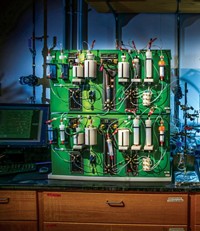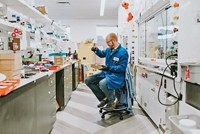Advertisement
Grab your lab coat. Let's get started
Welcome!
Welcome!
Create an account below to get 6 C&EN articles per month, receive newsletters and more - all free.
It seems this is your first time logging in online. Please enter the following information to continue.
As an ACS member you automatically get access to this site. All we need is few more details to create your reading experience.
Not you? Sign in with a different account.
Not you? Sign in with a different account.
ERROR 1
ERROR 1
ERROR 2
ERROR 2
ERROR 2
ERROR 2
ERROR 2
Password and Confirm password must match.
If you have an ACS member number, please enter it here so we can link this account to your membership. (optional)
ERROR 2
ACS values your privacy. By submitting your information, you are gaining access to C&EN and subscribing to our weekly newsletter. We use the information you provide to make your reading experience better, and we will never sell your data to third party members.
Start-ups
Bright Peak launches to develop synthetic proteins
Versant-backed biotech firm is building on technology from ETH chemist Jeffrey Bode
by Lisa M. Jarvis
July 28, 2020
Bright Peak Therapeutics has emerged from stealth with $35 million to develop synthetic protein therapeutics. The firm’s first project is an improved version of interleukin-2, a cytokine that in recent years has become hotly pursued as a cancer immunotherapy.
Incubated and backed by the venture capital firm Versant Ventures, Bright Peak is exploiting technology developed by ETH Zurich organic chemist Jeffrey Bode, who came up with a simple way to stitch together amino acid sequences.
Peptide synthesis is inherently limited to 40–50 residues, so over the years researchers have worked out ways to link those stretches into full proteins, Bode explains. In 2017, his group at ETH unveiled a new method that couples an αα-ketoacid and a hydroxylamine—what he calls a KAHA ligation—allowing sequences to be linked without having to rely on protecting groups or coupling agents.
While catching up over a drink a few years ago, Bode shared his early attempts to synthesize IL-2 with Versant’s Alex Mayweg, who was intrigued by both the underlying science and the project’s therapeutic potential. “Here is an opportunity now for creating proteins through the lens of synthetic chemistry—an almost small-molecule lens,” Mayweg says. In theory, the technology should allow drug developers to modify proteins to maintain their activity while improving properties like how long they linger in the body.
“It’s an amazing toolbox and playground,” Mayweg says. “We’re now just limited by our imagination.”
Meanwhile, companies were turning back to IL-2 as a potential cancer immunotherapy. A native form of the drug, Proleukin, was approved decades ago, but the drug’s use is limited by its instability in the bloodstream and propensity to activate certain immune cells that cause side effects. Other firms had begun to engineer IL-2 to address those two issues, but often could tackle only one or the other. Bode’s method should in theory allow chemists to make multiple protein modifications.
Versant decided to incubate the company at its labs in Basel, Switzerland, spending 18 months building and modifying proteins. Making a protein from scratch starts with scanning its structure to determine how best to take it apart—that is, how to divide it into roughly equal-sized stretches of amino acids that can be synthesized and easily sewed together using Bode’s ligation technology.
To tweak certain characteristics of the protein, researchers keep all the segments constant but one, which is manipulated combinatorially to create analogues, Mayweg says. With IL-2, that method was used to make three modifications that Bright Peak says will make the cytokine safer, more potent, and longer-lasting in the bloodstream.
A bonus of the technology, Mayweg says, is the ability to add chemical handles to proteins on which to hang other molecules. “Now the protein can become the starting point of another set of molecules,” he says. For example, IL-2 could be conjugated to other proteins or antibodies that direct the drug to a specific part of the body.




Join the conversation
Contact the reporter
Submit a Letter to the Editor for publication
Engage with us on Twitter